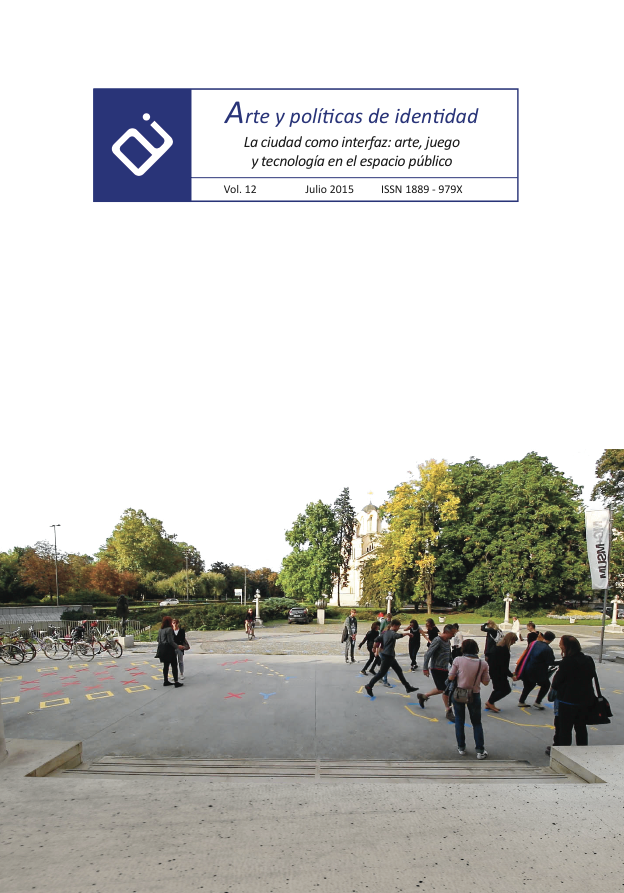Ludocracy: Play as Tool for Urban Revival at the Interface City
Abstract
We live in the city of fear. The excessive regulation and classification of what happens in our environment has pushed us into restricted rules of the game, in which there is no space left for improvisation, imagination or emotions. In this planned and managed environment by a few ones, the erroneous incorporation of the technology has increased the degree of control of the measurable variables, basing on them their public policy. This lack of care for intangible variables representing the human life of cities has caused, together with the introduction of the ICTs, the step towards the digital: a virtual place to achieve freedom and the debate that has been lost in the physical public space. Given this new physical-digital public space duality we consider its possible connection with the city as interface. The gamification of the processes of cities, the physical-digital hybridization of the urban games or the Lighter & Quicker & Cheaper concept are present in contemporary innovative projects reviewed below. As a proposal for the future we bet on ludocracy as an actuator mechanism for the reconquest of the physical public space showing the city as an augmented playground.Downloads
-
Abstract1282
-
PDF (Español (España))597
References
Baber, B., Karant, J., Küng, M., De Muynck, B., Pimlott, M., Voorthuis, J. (2005). Fear & Space. The view of young designers in the Netherlands. Róterdam: Urban Affairs.
Basar, D., Miessen, M. (2009). ¿Alguien dijo participar? Un atlas de prácticas espaciales. Barcelona: Dpr-Barcelona.
Baudrillard, Jean. (1993). Cultura y simulacro. Barcelona: Kairós
Benedikt, M. (1993). Ciberespacio: Los primeros pasos. Consejo Nacional de Ciencia y Tecnología México. México: Equipo Sirius Mexicana.
Borja, J. (1998). Ciudadanía y espacio público. Urbanitats nº 7: Ciutat real, ciutat ideal. Significat i funció a l’espai urbà modern, CCCB, Barcelona.
Castells, M. (2000). La era de la información: economía, sociedad y cultura. Volumen I, La sociedad en red. Madrid: Alianza.
Corsín Jiménez, A. (2014). The right to infrastructure: a prototype for open-source urbanism. Environment and Planning D: Society and Space, 32 (2) [html]. http://digital.csic.es/bitstream/10261/85115/1/right_infrastructure_finalpreprint.pdf
De Luca, V., Bertolo, M. (2012). Urban Games to Design the Augmented City. Eludamos. Journal for Computer Game Culture.2012; 6 (1), pp. 71-83 [html].http://www.eludamos.org/index.php/eludamos/article/viewArticle/vol6no1-7/6-1-7-html
Delgado, M. (2011) En busca el espacio perdido. Prólogo del libro Territorios de la infancia: diálogos entre arquitectura y pedagogía[html]. http://manueldelgadoruiz.blogspot.com.es/2011/11/en-busca-del-espacio-perdido-prologo.html
Deterding, S., Khaled, R., Nacke, L.E., Dixon, D., (2011) Gamification: Toward a Definition [html]. http://gamification-research.org/wp-content/uploads/2011/04/02-Deterding-Khaled-Nacke-Dixon.pdf>
Debord, Guy. (2002). La sociedad del espectáculo. Valencia: Pre-Textos
Di Siena, D. (2009). Espacios Sensibles. Departamento de Urbanística y Ordenación del Territorio de la Escuela Técnica Superior de Arquitectura de Madrid (UPM) [html]. http://urbanohumano.org/castellano/espacios-sensibles-hibridacion-fisico-digital-para-la-revitalizacion-de-los-espacios-publicos/>
Fratarelli, N. (2011). La ciudad mediática: El espacio público como amenaza. Revista Contratiempo nº3. Arte, Pensamiento y Política [html]. http://www.revistacontratiempo.com.ar/fratarelliciudad_mediatica.pdf
Gianetti, C. (2001) Reflexiones acerca de la crisis de la imagen técnica, la interfaz y el juego. Anàlisi 27: 151-158
Harvey, D. (2013). Ciudades rebeldes: Del derecho de la ciudad a la revolución urbana. Salamanka: Akal.
Infans’ Fans (2014). No hace falta nada, todo es necesario. La Ciudad Viva blog [html]. http://www.laciudadviva.org/blogs/?p=21871
Lévy, P. (2004). Ciberdemocracia. Barcelona: UOC. Serie Nuevas Tecnologías y sociedad.
Mañas, M., Pastor, M. (2014). Acontecimientos, torpezas y derivas: generadores ludocráticos. AusArt Journal for Research in Art. vol.2 nº1, p. 11-21 [html]. http://www.ehu.es/ojs/index.php/ausart/arthicle/view/11983
Navazo, M. (2013). Placemaking: ¿y esto de qué va? (I). La Ciudad Viva blog [html]. http://www.laciudadviva.org/blogs/?p=18170
Punset, E. (2012) Redes. ¿Por qué los niños se aburren en la escuela? [html]. https://www.youtube.com/watch?v=U2ql8CZwjws#t=51
Reyes, J. (2013). La ciudad interfaz: Nuevas formas de regeneración urbana en código abierto. Valencia; Diazotec [html]. http://offlinecity.files.wordpress.com/2014/01/ciudad-interfaz-estrategias-de-regeneracic3b3n-urbana-para-una-ciudad-opensource-jonathan-reyes.pdf
Ríos, F. (2014). Helium. Estrategias lúdicas de discusión y producción documental. Trabajo de Fin de Máster. Universidad Politécnica de Valencia
Sánchez Uzábal, A. (2009) Entrevista de Domenico di Siena a Alfonso Sánchez Uzábal [hmtl]. http://urbanohumano.org/castellano/sentient-city-entrevista-a-alfonso-sanchez-skotperez/
Shepard, M. (2011). Sentient City: ubiquitous computing, architecture and the future of public space. Nueva York: MIT Press [html].https://mitpress.mit.edu/books/sentient-city
Tonucci, F. (2002). Cuando los niños dicen: ¡Basta! Buenos Aires: Editorial Losada. S.A.UNICEF (2004). Deporte, recreación y juego [hmtl].http://www.unicef.org/spanish/adolescence/files/5571_SPORT_SP.pdf
Works published in this journal are subject to the following terms:
- The Service of Publications from the University of Murcia (publishing house) keeps the published works’ copyrights, and favors and allows the reuse of these works under the license indicated in point 2.
- Works are published in the journal’s online edition under the license Creative Commons Reconocimiento-NoComercial-SinObraDerivada 3.0 España(texto legal). They can be copied, used, disseminated, transmitted and publicly exhibited, as long as: i) the author and original source of publication are cited (journal, publishing house and work’s URL); ii) they are not used for commercial purposes; iii) the existence and specifications of this license are mentioned.
3. Conditions for auto-file. It is allowed and encouraged that authors share electronically their pre-print version (the pre-reviewed version) and /or post-print version (the reviewed and accepted version) of their Works before the publication, since it promotes its circulation and dissemination. RoMEO color: green.










